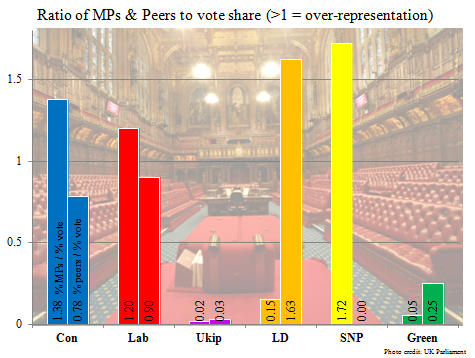Is the Lords really less proportionate than the Commons?
The Mail Online has a piece today stirring up anger about apparent plans to give the Lib Dems “up to six” new places in the House of Lords.
The story’s illustrated with an image comparing numbers of MPs, peers and votes for each party.
But the story compared the number of seats in the Lords with those in the Commons – as if the number in the Commons is, by definition, representative.
One could argue that the number of seats in the Commons is a good benchmark, because that’s what’s produced by the electoral system we have. But, that same logic could be used to argue that the number of seats in the Lords should also be appropriate – as that’s also the product of the system we have.
What I found difficult to grasp from their chart was how the relationship between votes and members in both the Commons and the Lords worked out for each party.
So I’ve redone the chart, dividing both Commons and Lords membership by popular vote:
Now, it’s still clear that the Lib Dems are over-represented in the Lords.
But that’s not by as much as the SNP are over-represented in the Commons. Ironically, the Mail piece has quotes from the SNP explaining how “absolutely absurd” the situation is.
And, between both Houses, both the Tories and Labour are on average more over-represented than the Lib Dems are (1.08 and 1.05 member per % vote respectively, compared with 0.89 for the Lib Dems).
While I find the Lords ridiculous, I’m not sure disproportionality is its greatest weakness – at least while the make-up of the Commons bears so little relationship to the popular vote.
